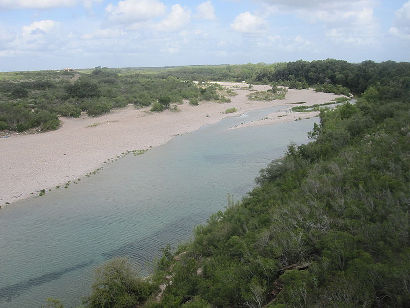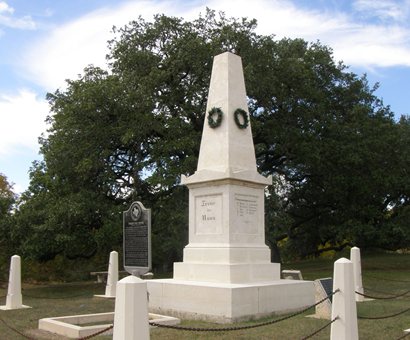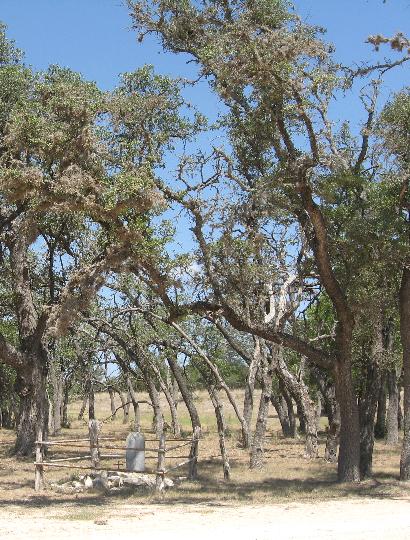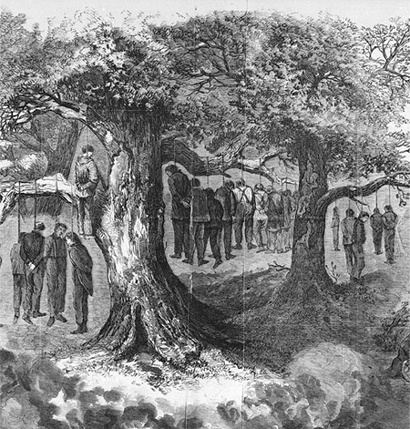|
Books by
Jeffery Robenalt
|
|
| Not
all Texans were in agreement about secession from the Union and many
more were opposed to the Confederate Conscription Act. Historians
estimate that nearly 30 percent of the Texas population had Unionist
sentiments, though the great majority, like Sam
Houston and James
Throckmorton, remained loyal to Texas.
However, as events would bear out, many dissenters paid a heavy price
for expressing their doubt of the Southern cause and their opposition
to the draft. Kangaroo courts were commonplace across the state and
vigilante justice was administered without mercy. Generally the punishment
meted out by the vigilantes was to burn the victim’s house or business
or to apply a painful coat of tar and feathers, but even murder and
lynching were far from uncommon. By 1863, most dissenters had either
learned to keep their opinions to themselves or had packed up and
fled south to Mexico or west to California. |
|
|
Robert
Edward Lee
General of the Confederate Army
Wikimedia Commons |
After April
1862, much of the dissent throughout the South centered on the new
Conscription Act and Texas was no exception. An incredible number
of Texans had already volunteered for service with the Confederate
army, but the ongoing slaughter in the east required a constant flow
of manpower. To fill this void, General Robert E. Lee was instrumental
in securing the passage of the Confederate Conscription Act, though
the concept of the draft law was just as unpopular in the south as
it was to later prove in the North. The Texans who were eager to fight
had long since volunteered to serve, and there was insufficient manpower
remaining in the state to protect the frontier from the depredations
of the Comanches and maintain the agrarian economy.
To make matters worse, the draft law was both poorly drawn and even
more poorly executed. Discrimination was rampant, and the law was
applied unevenly. Even petty officeholders were exempt, as were all
men “considered indispensable.” This poorly drafted phrase would be
the cause of much abuse. Some exemptions like those for doctors and
men assigned to frontier defense were sensible, but any man of means
was permitted to pay a poorer man to stand in his place. Finally,
the fact that the “indispensable” provision was interpreted to include
almost all men of property was bitterly resented by both the civilian
population and most of the men in the army—volunteers included.
|
|
|
Confederate
General Paul Octave Hebert
Wikimedia Commons |
Thousands of
angry citizens across the state attended protests of the draft law.
Many of the protests were near riots, and in May General Paul Octave
Hebert, the recently appointed commander of the Military Department
of Texas, declared all of Texas to be under martial law. Hebert was
a West Point graduate who had spent much of his service in Europe
where he developed a continental military style that Texans found
displeasing in the extreme. Writer Thomas North described him as preferring
“red-top boots, a rat-tail moustache, fine equipage, and a suit of
waiters . . . He was too much of a military coxcomb to suit the ideas
and ways of a pioneer country.”
General Hebert set about establishing martial law and administering
the draft by appointing local provost marshals and providing them
with virtually unlimited authority. Both Governor Lubbock and the
Texas Supreme Court upheld Hebert’s actions, thus there was no appeal
from the decision of a provost marshal. They were answerable only
to General Hebert. Ruthless enforcement of the draft and the unpopular
property confiscation codes drove some parts of the state into actual
resistance and protests were commonplace. Age was always a question
where birth certificates did not exist and records of any kind were
rare. Provosts, often young and inexperienced second lieutenants,
decided who was old enough to conscript and young boys who resisted
were hunted down without mercy.
The taking of property under the confiscation codes may have aroused
even more ire than the draft law. Under the codes, the property of
all persons adjudged to be “disloyal” was subject to sequester. Of
course, the local provost marshal had the power, if not the wisdom,
to decide the question of loyalty. There were blatant cases where
the lands of men who were imprisoned in the North were confiscated
without the right of appeal, and even the lands of men who happened
to be fighting for the Confederacy in another state were wrongfully
seized. Those who were identified as loyal to the Union suffered the
worst of all. On many occasions, the lands of individuals who expressed
Unionist sympathies were forfeit even when it could not be proven
that they had committed an overt disloyal act.
Dissent
went far beyond mere protest in north Texas where many immigrants
from the North had established prosperous farms and also in the German
counties of the Texas
Hill Country, especially Gillespie,
Kerr, and Kendall.
Many of the settlers in these counties were German intellectuals,
Freethinkers who came to Texas in 1848 after attempting to stage a
revolution. When the revolution failed, their choices were either
immigration or prison. Of course such people opposed slavery. Only
33 slaves resided in Gillespie
County in 1860. However, the Germans had refrained from public
protest until secession finally forced their hand. Gillespie
County’s strong opposition to secession—evidenced by a vote
of 400 to 17 against—was not based solely on a hatred of slavery.
The Hill Country
was on the edge of the frontier, and the withdrawal of the U.S. Army
meant renewed attacks by the Comanches.
The Confederate government in Austin
did virtually nothing to protect the Texas frontier, and the state
militia was of little help. Moreover, the hasty formation of the militia
gave rise to some units that were more outlaws than soldiers, using
the guise of the Confederacy to rob and terrorize the remote ranches
and farms along the frontier. The Germans called these outlaw bands
“Die Hagerbande” or the Hanging Bandits. With their homes and communities
at risk, the Germans were not only opposed to the war on principal,
but were also determined to resist conscription out of the need for
self-defense. To meet this need, they organized their own militia
called the Union Loyal League. |
|
|
Confederate
General Hamilton P. Bee
Wikimedia Commons |
|
The Confederate
government in Austin sent
notorious Confederate irregular Captain James Duff to Fredericksburg,
the county seat of Gillespie
County, in April 1862 to enforce conscription and disband the
Union Loyal League. Duff, a man of questionable character, had been
dishonorably discharged from the U.S. Army. He demanded that all
Unionists take an oath of allegiance to the Confederacy or be declared
traitors, stating that “the God damn Dutchmen are Unionists to the
man,” and “I will hang all I suspect of being anti-Confederates.”
Duff’s actions caused the Hill
Country to erupt in turmoil, and General H. P. Bee, the commander
of South Texas, virtually declared war on the entire area, causing
hundreds of men to flee, some into the waiting arms of the Union
army.
In early August, 1862, Fritz Tegener, a German language scholar,
led sixty-five dissenters, men and boys, south from Fredericksburg
and Comfort
toward the Rio Grande. Once they crossed into Mexico, the Germans
hoped to catch a ship for Union-held New Orleans. They were armed,
but their immediate purpose was to flee the state, not fight the
Confederacy. However, when Duff learned of the flight he sent Lieutenant
C.D. McRae and ninety-four men after the Unionists. Not expecting
close pursuit and with little military experience, the Germans set
up camp on the Nueces River about twenty miles from Fort
Clark in present-day Kinney
County without choosing a good defensive position or posting
a guard. McRae and his men came upon the camp late in the afternoon
of August 9, but waited until early the following morning to launch
their attack.
|
 |
Nueces River
between La Pryor
& Uvalde,
TX
July 2010 photo courtesy Billy Hathorn, Wikimedia Commons |
Firing began
an hour before sunrise, as the confederates swept down on the sleeping
camp. The fighting was hot and of the Unionists, 19 were killed—some
trampled to death in their bedrolls—and 9 were wounded. Twenty-three
of the remaining Germans escaped into the surrounding hills, but 8
more were killed by the Confederates on October 18, while trying to
cross the Rio Grande. The battle was also a minor disaster for McRae,
who suffered 12 killed and 18 wounded, including himself. McRae ordered
his men to set up camp and tend to their wounded. At first, the Confederates
also cared for the Germen wounded, but later in the afternoon the
wounded Unionists were carried outside the camp and executed.
Both contemporary and eye-witness accounts of the incident on the
Nueces River are conflicting. Some state that the wounded prisoners
were executed on the spot, not later in the day as related here. Accounts
also vary as to the number of participants in the fighting and the
number of killed and wounded on both sides. Even the very nature of
the tragic incident is in question. Confederate sympathizers consider
the fight a military action against a band of insurrectionists, but
many German residents of the Hill Country, focusing on the execution
of the wounded, regard the event as a massacre of the innocent. Nearly
all organized German resistance ceased when word of the “Battle of
the Nueces” spread, and many men fled to the safety of the frontier
where robbery, lynching and murder continued across the Hill
Country until the end of the war. After the war a monument to
the German dead was dedicated in Comfort.
|
 |
Yet
another tragic Hill
Country incident occurred in July 1863, when eight well mounted,
well armed and well provisioned men and a young boy paused in the
small settlement of Bandera
on their journey from Williamson
County to Mexico. The men made no secret of their intent to ride
to Mexico to purchase prime ranch stock, and they all appeared quiet
and peaceful, paying for everything before they departed. Ironically,
two of the men were home on leave from Confederate service. Word of
the small party's presence was soon carried to nearby Camp
Verde, and a troop of 25 Confederates under the command of Major
W. J. Alexander, misinterpreting the men's ride to Mexico as an attempt
to avoid service in the war, started off in pursuit. In the pursuing
party were several men well known to the local settlers of Bandera,
but they all disappeared soon after the war.
Picking up the trail in Bandera,
Major Alexander and his men followed it a few miles beyond the settlement
of Hondo
to Squirrel Creek where they came upon the small party. Not knowing
they were being pursued, the Williamson
County men had just finished their noonday meal and were quietly
resting. The Confederates quickly surrounded the unsuspecting men
and Major Anderson called upon them to surrender, giving them his
word that if they would quietly submit, they would receive a fair
trial by court-martial at Camp
Verde. With little choice and with knowledge that they had committed
no crime, the eight men freely surrendered their arms. After being
relieved of the nearly $1,000 in cash they carried to purchase stock,
the prisoners were forced to saddle their horses and immediately start
back for Camp
Verde.
All went well until the following evening when some of the Confederates
suggested that the prisoners should be hung for attempting to flee
the state. Some historians have suggested that the $1,000 the Williamson
County men were carrying may have had a bearing on the decision
to hang them. Whether or not this was true, what may have well started
out as a prank quickly turned serious when Major Alexander turned
a blind eye to the situation and did nothing to put a stop to the
foul plan. A few Confederates refused to take part in the hanging
and chose to mount up and ride out, but the others marched the prisoners
a short distance from camp to a suitable live oak where they were
hung one by one.
A noose was quickly tied at the end of a horse hair rope and tossed
over the limb of the tree. Each of the Williamson
County men died by strangulation, being slowly drawn off their
feet until they choked to death. When the first man was dead, he was
let down and the rope was cut, leaving the noose still about his neck.
A new noose was quickly fashioned and the next man was hauled up.
One of the victims begged to be shot, saying that he much preferred
that manner of death to being slowly strangled. A Confederate complied
by firing a rifle at the prisoner, but he fell only wounded. Another
Confederate then shoved the muzzle of his rifle against the prisoner's
chest and pulled the trigger. He had mistakenly left the ramrod in
the weapon and it went through the prisoner, pinning his body to the
ground. When the bodies were discovered the next day, the ramrod was
mistaken for an arrow and at first the killings were blamed on Indians.
The young boy was said to have escaped, but he was never heard from
again. |
 |
After the war,
the atrocity was remembered and the incident was referred to a military
tribunal. Major Alexander and his men were eventually indicted for
murder, but no one was ever arrested or tried for the crime. Today,
only the hanging tree, a fence and a simple tombstone inscribed with
the names of the eight Williamson
County men who lie beneath the tree in a common grave mark the
site of the heinous crime. Below the names, the tombstone reads" "Remember,
friends, as you pass by, as you are now, so once was I. As I am now,
you soon will be; prepare for death and follow me."
The
Gainesville-Sherman
area north of Dallas was
another center of dissent and was also perceived by some as a scene
of tragedy. The Butterfield Overland Mail route that began in St.
Louis ran through Gainesville
and brought many new settlers into Cooke
County from the upper South and the Midwest. By the start of the
war, fewer than 10 percent of the area households owned slaves. As
unrest over secession and the onslaught of the war grew, the slaveholders
increasingly feared the influence of the newcomers, and in the summer
of 1860 several slaves and a Northern Methodist minister were lynched
on suspicion of launching an uprising. When Cooke
County and a few other surrounding northern counties voted heavily
against secession, the slave holders believed their fears were justified.
In April 1862, the new Conscription Act gave rise to the first actual
opposition to the Confederate government in Cooke
County. A provision of the draft law exempting large slaveholders
from conscription angered many people who believed that since the
slaveholders were the cause of the war in the first place, they should
be among the first called to service. In an act of protest, a group
of thirty men signed a petition and sent it to Richmond. When word
of the petition reached Gainesville,
the local militia commander General William Hudson exiled the leader
of the group, but the other members began to organize a Union League.
Not many men joined the league and the effort was unorganized, but
rumors began to spread of a membership of more than 1700 and plans
to attack the local militia arsenal. |
 |
Hanging of Union
Men in Gainesville
From
Frank Leslie's Illustrated Newspaper.
Prints and Photographs Collection 1993/202-5-4.
Texas State Library & Archives Commission |
|
On the morning
of October 1, state troops under the command of Colonel James G.
Bourland, a slaveholder, arrested 150 men in Gainesville.
With the assistance of Colonel William C. Young another slave owner
who was home on sick leave from the 11th Texas Cavalry, Bourland
organized a hasty “citizen’s court” of twelve jurors, seven of which
were also slaveholders. On a majority vote, the jury condemned seven
influential Unionists, but the angry mob was impatient and lynched
fourteen more men without the benefit of a trial. Things got even
worse for the Unionists the following week when an unknown assassin
killed Colonel Young. Nineteen more Unionists were quickly convicted
and hung. Their execution was supervised by the Colonel’s son.
|
|
|
Postwar
portrait of Jefferson Davis by Daniel Huntington
Wikimedia Commons |
|
Texans in general
and every newspaper in Texas celebrated the hangings. The Unionists
were compared to traitors and common thieves and branded as in league
with Kansas abolitionists and the Lincoln Administration. Texas
Governor Francis Lubbock, known to all as an ardent secessionist,
lauded the actions taken by the citizens of Gainesville.
However, not all southerners were pleased with the hangings. President
Jefferson Davis was so embarrassed that he withdrew his enquiry
into a similar incident involving Union soldiers in Missouri. Davis
also relieved General Paul Octave Hebert the military commander
of Texas for abusing the concept of martial law and replaced him
with General John Bankhead Magruder.
|
Hanging and Flogging
in Gainesville
From
Frank Leslie's Illustrated Newspaper.
Prints and Photographs Collection 1993/202-5-6.
Texas State Library & Archives Commission |
The hangings
in Gainesville
were not the end of the violence or the dissent in Texas. Many Unionists
fled to the North, to Mexico or to California, and the ones who remained
in Texas did their best to keep a low profile, although that did not
always keep them safe. Captain Jim Young continued his pursuit of
revenge when he killed E. Junius Foster for applauding his father’s
death and tracked down Dan Welch, the man he accused of his Father’s
assassination. Young returned Welch to Cooke
County and had him whipped and lynched by a few of the family
slaves. A company of north Texas Confederate soldiers serving in Arkansas
nearly mutinied when they got word of the hangings, but their commander
General Joseph Shelby managed to diffuse the situation. Several of
the soldiers later deserted and returned home, but Shelby's actions
had prevented a mass attack on Gainesville.
However, ill feelings over the incident would continue to simmer until
the end of the war.
© Jeffery
Robenalt
"A Glimpse of Texas Past"
May 1,
2013 Column
jeffrobenalt@yahoo.com
References
› |
References
for "Dissention and the Draft in Civil War Texas"
|
|
Sam Hanna Acheson
and Julia Ann Hudson O'Connell, eds., George Washington Diamond's
Account of the Great Hanging at Gainesville, 1862 (Austin: Texas
State Historical Association, 1963).
Walter F. Buenger,
Secession and the Union in Texas (Austin: University of Texas
Press, 1984).
L.D. Clark,
A Bright Tragic Thing (El Paso: Cinco Punto Press, 1992).
Claude Elliot,
"Union Sentiment in Texas, 1861-1865," Southwestern Historical
Quarterly, 50:4 (April 1947).
Robert Pattison
Felgar, Texas in the War for Southern Independence, 1861-1865
(Ph.D. dissertation, University of Texas, 1935).
Richard B.
McCaslin, "GREAT HANGING AT GAINESVILLE," Handbook of Texas
Online (http://www.tshaonline.org/handbook/online/articles/jig01),
accessed December 19, 2012. Published by the Texas State Historical
Association.
Stanley S.
McGowen, "Battle or Massacre?: The Incident on the Nueces, August
10, 1862," Published in the Southwestern Historical Quarterly,
Vol. 104, July 2000-April 2001.
James Smallwood,
"Disaffection in Confederate Texas: The Great Hanging at Gainesville,"
Civil War History 22 (December 1976).
Rodman L. Underwood,
Death on the Nueces: German Texans Treve der Union (Austin,
Eakin Press, 2002).
|
|
|
